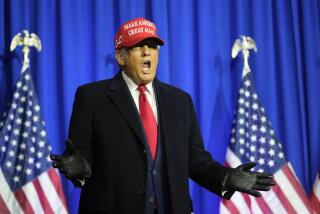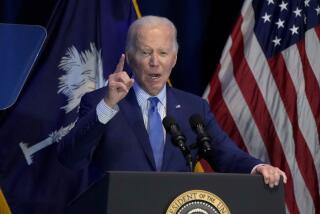U.S. economy’s growth falls short of Trump’s 3% goal for 2018
The nation’s economic growth declined at the end of last year for the second straight quarter, denying President Trump the 3% annual increase he had promised that Republican tax cuts would spur.
And growth this year and next won’t hit that level either, economists said.
Total economic output, also known as gross domestic product, grew 2.9% in 2018, the Commerce Department said Thursday in a report that was delayed several weeks because of the partial shutdown of the federal government. It was the first of three estimates and could be revised up or down in the coming weeks.
The report showed that last year’s economic performance, although strong, fell just short of the annual growth that Trump and his advisors had confidently proclaimed in recent months would be a slam-dunk after the stimulus from the tax cuts that took effect at the start of last year.
That means Trump so far has failed to achieve something Republicans have repeatedly criticized President Obama for failing to do: Grow the U.S. economy at least 3% in a calendar year.
The best year under Obama was 2.9% in 2015. The economy grew 2.2% in Trump’s first year in office. The last time annual growth topped 3% was in 2005, when the economy expanded by 3.5%.
“I think we could go to 4, 5 or even 6%, ultimately,” Trump said of economic growth in late 2017 as the tax cut legislation was finalized.
Trump didn’t mention the economic growth figures when he spoke in Alaska on Thursday during a stop on his way back from a summit with North Korea’s leader in Vietnam. But he did tout the economy broadly.
“Our economy is probably as good as it’s ever been or better,” he said, repeating an assertion he has frequently made in recent months, but that most economists dispute.
Despite the new data, which included a 2.6% annual growth rate for the fourth quarter, Commerce Secretary Wilbur Ross made a similar argument Thursday.
“President Donald Trump has unleashed American growth at a pace the experts thought was not possible, approaching 3% real GDP growth in 2018,” he said.
Experts said the economy, particularly after a big stimulus like the tax cuts, could come close to or exceed 3% growth for a year — after all, it hit 2.9% as recently as 2015 — but argued that sustaining that would be difficult.
Larry Kudlow, the top White House economic advisor, said that the administration’s policies were working and predicted 3% annual growth “as far as the eye can see.” Although the calendar-year figure came in just below the administration’s goal, he noted that the economy grew 3.1% when comparing the fourth quarter of 2017 to the fourth quarter of last year.
“I would just call it a 3% year,” Kudlow told CNBC.
But that’s not the bar Trump and Republicans set.
They did not round up the 2.9% growth in 2015 under Obama to 3%. And they specifically targeted calendar-year growth because Obama presided over three 12-month periods in which U.S. growth exceeded 3%. The first of those periods was October 2009 through September 2010. Then there were two overlapping periods: April 2014 through March 2015 and July 2014 through June 2015.
Although economic growth can be calculated by comparing fourth-quarter data, the Commerce Department’s Bureau of Economic Analysis produces the government’s official figures based on a formula that compares average annual growth from January through December. That formula produced the 2.9% figure for 2018 reported Thursday.
Last year probably was Trump’s best opportunity to top Obama’s annual growth high. The Federal Reserve, the International Monetary Fund and most economists are forecasting that U.S. growth will slow this year to about 2.5% or less.
Mark Zandi, chief economist at Moody’s Analytics, predicted that 2018 would be the high-water mark for economic growth for Trump’s term.
“There’s no way he’s going to even come close going forward,” Zandi said. “It wasn’t even the best year in the expansion.”
Zandi calculated economic growth to two decimal places and found that 2018’s figure was 2.88%, exactly the same as in 2015.
“There’s no evidence that the [Trump administration] policies are lifting underlying growth in the economy” beyond their long-term trends, Zandi said.
The tax cuts provided a short-term stimulus in the first half of 2018. But that came at a cost. The law is expected to reduce revenue by $1.5 trillion over a decade. The effect was quickly felt as the federal budget deficit jumped 17% in the 2018 fiscal year compared with the year before.
The rising deficit has produced some drag on the economy. On top of that, the government shutdown is expected to be a big hit to growth in the first three months of this year, which could lower the 2019 forecasts.
And the outlook for 2020 isn’t any better, with some predicting a recession could be underway by then.
A survey of about 450 U.S. bank executives by Promontory Interfinancial Network found that 29% expected a recession to begin this year, and 52% predicted one would start in 2020.
“In spite of a strong U.S. economy, a corporate tax cut that helped banks earn record profits in the second and third quarters of 2018, and enactment of regulatory relief legislation, bankers have become increasingly pessimistic about the future,” said Mark Jacobsen, Promontory’s chief executive.
Zandi said the stimulus from the tax cuts was muted because it was delivered into an economy at near-full employment, which led the Federal Reserve to increase interest rates in an attempt to head off high inflation.
The Fed raised its key rate a full percentage point in 2018 before indicating it would hold off on more increases this year as the U.S. and global economies slow.
“They threw the tax cuts on top of a full-employment economy and they got higher interest rates as a result, which knocked the wind out of housing, hurt investment and stole away from growth, which is exactly what one would expect,” Zandi said of Trump and the Republicans.
“The only surprise is they were surprised” the stimulus did not produce stronger growth, he said.
The Republican legislation reduced tax rates across the board and slashed the corporate rate to 21% from 35%. Though that led companies to boost investment by 6% last year compared with 4.8% the previous year, it also fueled a record-setting $1 trillion in stock buybacks.
The Trump administration also adjusted tax withholding tables to put more money into workers’ paychecks last year. That led to a decline in tax refunds early in this tax filing season that could hurt consumer spending, although new data released Thursday show the average refund through Feb. 22 is up 1.3% compared with the same point last year.
Trump’s trade war with China, the initial effects of the government shutdown precipitated by the president’s demand for border wall funding and the easing of the tax-cut stimulus all combined to push economic growth down to 2.6% in the fourth quarter.
The figure was slightly better than economists expected, but still down sharply from 3.4% growth in the third quarter. Boosted by the tax cuts, the economy grew at a 4.2% annual rate in the second quarter of the year, the best since 2014.
But the initial tax-cut stimulus faded as Trump’s trade war with China accelerated. Consumer spending declined in the fourth quarter to 2.8%, the second straight drop, the Commerce Department said. U.S. exports declined 4.9% in the third quarter before rebounding to 1.6% growth in the fourth quarter.
“The good news is that we’re still on firm footing for the moment,” said Diane Swonk, chief economist at consulting firm Grant Thornton. The biggest thing the U.S. economy has going for it, she said, is the sustained strength in the labor market, which has been driven in particular by job gains among young women.
Yet, like most economists, Swonk sees growth sliding this year to closer to 2%.
The U.S. economy ended 2018 with four straight quarters of declining residential construction. So far this year, retail sales and industrial production have tailed off as well. If a trade deal with China doesn’t come through, and tensions between the two economic powerhouses remain elevated or get worse, that could cause a much sharper slowdown here, Swonk said.
Times staff writer Don Lee contributed to this report.







